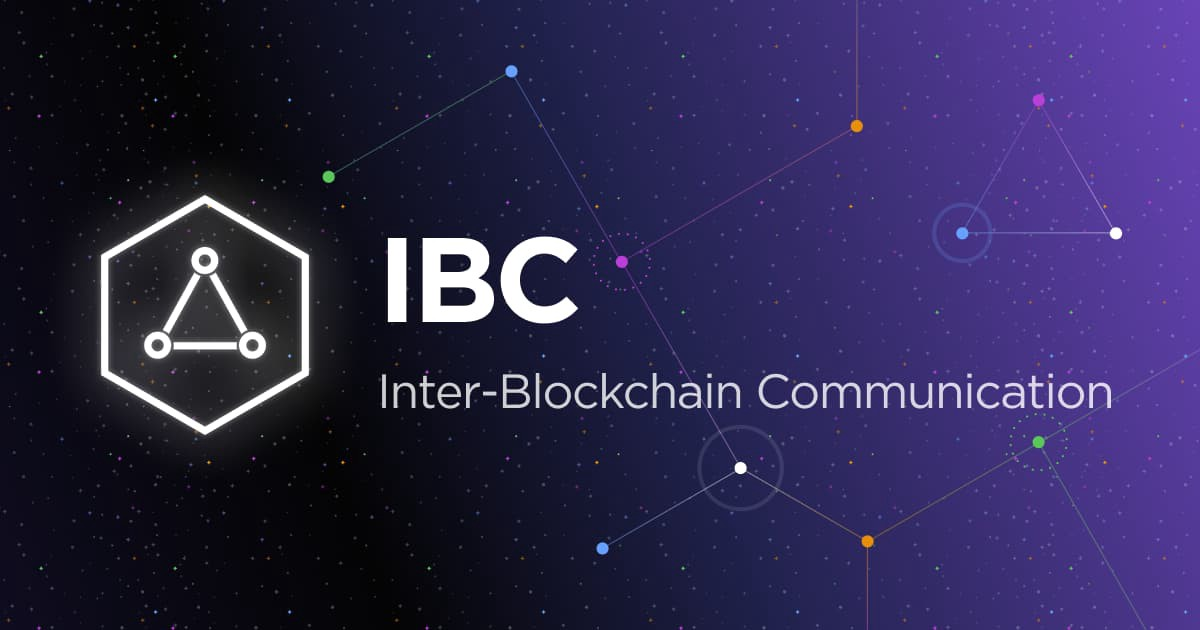IBC protocol - Complete Blockchain Guide

Cosmos is a decentralized network of independent, scalable, and interoperable blockchains, designed to improve the scalability, usability, and security of blockchain technology. The Cosmos protocol uses a consensus mechanism called Tendermint BFT to ensure the security and stability of its network, and provides a platform for developers to build decentralized applications and custom blockchain solutions.
At its core, the Cosmos network aims to solve the problem of blockchain interoperability, allowing different blockchain networks to exchange data and assets with one another. This is done using the Cosmos IBC protocol.
Lets dive deeper to understand what is IBC and how it works.
What does IBC mean?
IBC stands for Inter-Blockchain Communication. It is a protocol for allowing communication and transfer of data and assets between different independent chains. IBC enables the transfer of digital assets, such as tokens, from one blockchain to another in a secure and decentralized manner within the blockchain ecosystem.
What is the inter blockchain communication protocol (ibc)?
The use of IBC has the potential to greatly improve the interoperability and interconnectivity of different blockchain networks, allowing for the creation of a more seamless and connected decentralized ecosystem. The Cosmos network is one example of a platform that utilizes the IBC protocol to facilitate communication and asset transfer between two chains.
Who created IBC protocol?
The Cosmos Blockchain, an ecosystem of connected blockchain networks that was founded in 2014 by Jae Kwon and Ethan Buchman. The goal of Cosmos is to create a decentralized network of independent, scalable, and interoperable blockchains that can communicate with each other and exchange information and assets in a secure and decentralized manner. Development of the IBC protocol was a key part of the Cosmos project, as it enables multichain interoperability between protocols. The IBC protocol has been implemented and integrated into the Cosmos network, and is now used by developers and businesses to build decentralized applications and solutions that can interoperate with other blockchains in the Cosmos ecosystem using cosmos sdk. Most Cosmos applications execute on their own purpose-built blockchain running their own blockchain validator set
How IBC works?
The IBC protocol enables the transfer of digital assets, such as tokens, from one blockchain to another in a secure and decentralized manner. It allows for the creation of a more connected and interoperable ecosystem of decentralized applications and token transfers.
Here is a step-by-step guide on how IBC protocol works;
- Secure Connections: The first step in IBC is to establish a connection between two blockchains. This is done by creating a proof of the existence of the other blockchain and establishing a secure channel for communication.
- Packet Transfer: Once a connection has been established, data and assets can be transferred between blockchains in the form of "packets". Each packet contains information about the type of asset being transferred, its origin, and its destination.
- Authentication: Before a packet can be processed, it must be authenticated by the receiving blockchain. This is done using cryptographic techniques, such as digital signatures, to ensure that the packet is legitimate and has not been tampered with in transit.
- State Transfer: Once a packet has been authenticated, the receiving blockchain will process it and update its state to reflect the transfer of the asset. The asset is now recognized by the receiving blockchain and can be used within its ecosystem.
- Cross-Chain Consensus: The IBC protocol also ensures that transfers are consistent and secure by requiring that both blockchains reach consensus on the transfer of the asset. This is done by incorporating the transfer into both blockchains' blocks and verifying that the transfer has been recorded in both blockchains' ledgers.
- Dispute Resolution: In the event of a dispute, IBC provides mechanisms for resolving conflicts between blockchains. This includes protocols for reporting and resolving disputes, as well as rules for determining which blockchain's state should be considered the authoritative state in the event of a disagreement.
How to use IBC protocol?
To use IBC, you will need to integrate the protocol into your blockchain. This involves writing code to implement the IBC standards and rules, as well as integrating it into your blockchain's consensus mechanism to ensure that transfers are secure and consistent.
Which Blockchain network uses IBC protocol?
In addition to the Cosmos network, other blockchain networks and platforms are also exploring the use of IBC to facilitate communication and asset transfer between different blockchains. This includes projects in the decentralized finance (DeFi) space, as well as other projects that are focused on improving the interoperability and interconnectivity of different blockchain networks.
Importance of IBC protocol for blockchain.
TCP/IP (Transmission Control Protocol/Internet Protocol) is one of the most important protocols for the Internet and networks, and it is essential for the functioning of the Internet and the connected networks. The protocol provides the foundation for data communication on the Internet and other networks. It defines how data should be transmitted over the network, and it provides end-to-end communication by defining how data should be packaged, transmitted, and received.
Just as TCP/IP enables communication between interconnected network and allows them to share information and resources in a unified way, the IBC protocol will provide necessary infrastructure standard for the blockchain technology as mentioned by Josh Lee in the following article. https://medium.com/chainapsis/why-interchain-accounts-change-everything-for-cosmos-interoperability-59c19032bf11
Similar to the TCP/IP protocol, the unique aspect of IBC is that it separates the ‘application layer’ from the ‘transport and network layer’ (or TAO, transport, authorisation, organisation). This means that IBC defines how data is sent and acknowledged across blockchains, but it doesn’t define what that data is or how it should be structured. This sets IBC apart from other interoperability solutions which require a lot more standardisation in the application layer. Adding additional requirements for standardisation can add a layer of politics which decreases the diversity of blockchain architecture that can exist in the interoperable network.
What is the difference between IBC and Bridge?
The main goal of IBC is to allow interoperability between different blockchain networks, making it possible for assets to be transferred across different blockchain systems, even if they use different consensus mechanisms or programming languages.
On the other hand, a Bridge is a specific implementation of the IBC protocol, designed to enable communication between two specific blockchain networks.
What is multichain interoperability?
Multichain interoperability involves connecting different blockchain networks, allowing them to interact with each other, and facilitating the transfer of digital assets and information between them. Interoperability is important for several reasons. Firstly, it enables different blockchain networks to utilize the strengths of each other, such as increased security, scalability, or privacy. Secondly, it allows for the creation of new decentralized applications that can utilize assets and information from multiple blockchain networks. Finally, multichain interoperability can lead to increased adoption of blockchain technology by enabling seamless integration with existing systems and processes.
Limitations of IBC protocols
While IBC (Inter-Blockchain Communication) protocols offer several advantages, they also have some limitations:
- Complexity: Implementing IBC protocols can be complex, requiring a high level of technical expertise and resources. This can be a barrier to entry for smaller blockchain networks or organizations that lack the necessary resources to implement IBC protocols.
- Lack of standardization: Currently, there is no widely adopted standard for IBC protocols, which can lead to compatibility issues between different implementations. This can limit the ability of different blockchain networks to communicate with each other effectively.
- Security risks: As with any cryptographic technology, IBC protocols are not immune to security risks. For example, if an IBC protocol is poorly implemented, it could leave the system vulnerable to attacks, such as data breaches or theft of digital assets.
- Performance issues: IBC protocols may introduce additional latency and performance issues, particularly when transferring large amounts of data or assets between different blockchain networks.





